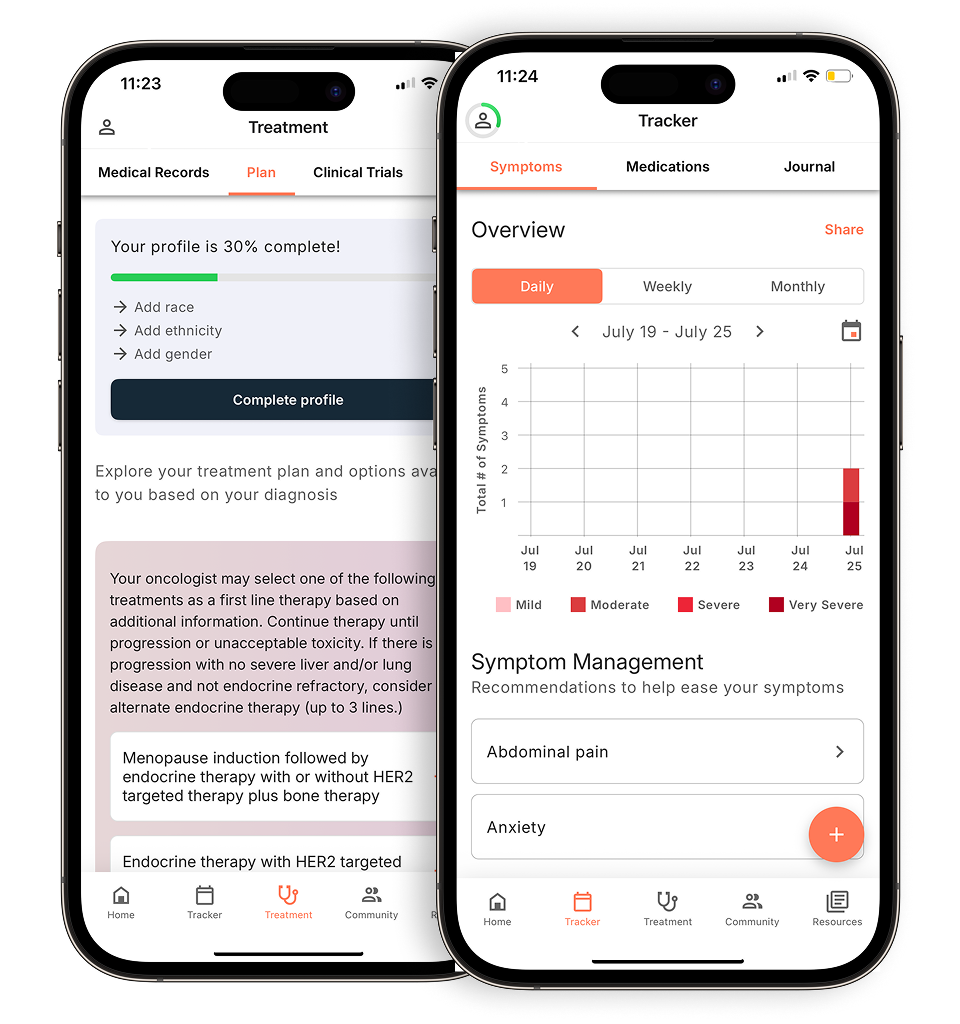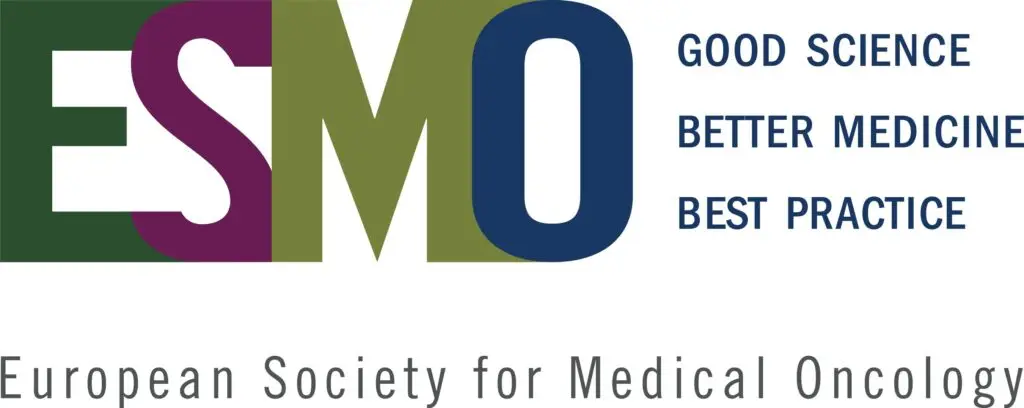Click below to watch a full recording of the ESMO 2022 Highlights webinar.
Recap by Suzanne Garner, Director of Marketing and Patient Engagement at Outcomes4Me
Outcomes4Me “Ask the Expert” webinars provide the latest innovations and research information to our breast cancer community from some of the top minds in the field. Recently we had the privilege to welcome breast oncologist Dr. Erica Mayer from Dana Farber Cancer Institute to summarize the latest research findings from the European Society for Medical Oncology (ESMO) Congress 2022. ESMO Congress is Europe’s most prestigious oncology conference for the world’s top oncologists and cancer researchers. The research studies shared at conferences like ESMO Congress often become the basis of clinical guideline updates. The following is a summary of the meeting update and Q&A with Dr. Mayer.
Q: What new information was shared regarding the trials using CDK4/6 inhibitors in metastatic breast cancer?
Dr. Mayer: I think the most important message we have now is— we really have a choice in which of the three CDK 4/6 medicines we offer patients. Until about June (2022), many people were given palbociclib as the partner agent with endocrine therapy. That’s what has been most popular around the world mostly because it is a very well-tolerated drug, and it’s a drug where we are very good at managing any side effects. Since the data presented at ASCO, there’s been a little shift, and now more patients are being given ribociclib, although, for people who are on palbociclib and doing well, we want them to continue on that drug.
Now we have the data supporting abemaciclib as well. Abemaciclib has a slightly different toxicity. For example, it’s a little more likely to cause diarrhea than ribociclib. The ribociclib is a little more likely to cause some liver irritation. So if there’s a specific situation going on with a patient where we need to be mindful of these side effects, that can influence how we select.
There’s still a lot more data to be coming out about CDK4/6 inhibitors, but these drugs are very important in our breast cancer management. This data is helping us refine our drug selection to get the best possible outcomes for our patients.
What is the difference between progression-free survival and overall survival in trial results?
Dr. Mayer: We in the breast cancer community spend a lot of time discussing this topic amongst ourselves. I think we all agree that the most important thing is live as long as you can—survival. That’s always been the north star guiding all of the research.
But looking at that as an endpoint from a research point of view is a little harder because it takes a long time to mature that data. It involves not just the initial treatment. Let’s say someone is getting abemaciclib, and they’re on it for quite some time. Then if the cancer worsens, they have to switch to something else. There may be many, many switches that happen between that initial time of switching and the overall survival.
So it’s measuring not just that initial step, but it’s measuring many other steps beyond what we call post-progression. It becomes a little complicated to interpret the data and particularly the differences between progression-free and overall survival. Essentially, survival is what matters most, and that should be what is guiding our clinical decision-making and also guiding how we approve drugs to be used for breast cancer.
Evidence-based guidance powered by NCCN Guidelines®
Personalized treatment plans shaped by the latest oncology standards—tailored to your diagnosis.
Get started
View your personalized treatment plan in the Outcomes4Me app
Use your diagnosis to unlock personalized NCCN Guidelines®-aligned recommendations.
Continue in app
Will Trodelvy become a standard of care option soon?
Dr. Mayer: That’s another exciting piece of data we saw at ESMO. Trodelvy is also known as sacituzumab or sacituzumab govitecan. This is a type of medicine we call an antibody-drug conjugate. Again, not chemotherapy and not a hormone medicine, but it is a targeted type of medicine. It’s a drug that tries to target a receptor on the outside of the cancer cell using an antibody. Linked to the tail end of the antibody is a teeny-tiny bit of very potent chemotherapy.
The idea is that we’re using the drug—I use it for analogies when I think about this, but it’s like a trojan horse, or it’s a smart bomb, but it’s trying to get that chemotherapy into the cancer cell very precisely to focus on killing the cancer cell and try to minimize what we might think of as off-target toxicity causing side effects somewhere else in the body. Sacituzumab is a drug that was primarily designed to look at a receptor that we found on triple-negative breast cancer and is currently approved to treat triple-negative breast cancer.
What is Ki67?
Dr. Mayer: Ki67 is a test that’s done by pathologists in the pathology lab. Just like I mentioned, estrogen receptor, progesterone receptor, and HER2. Those are staining tests that are done in the pathology lab. Ki67 is another staining test that’s done in pathology labs. It’s basically a test of proliferation. Is the cancer growing more rapidly? Or is it more sleepy and slow growing?
Ki67 has been in the news more recently because we did have a drug approval about a year and a half ago for one of the CDK4/6 inhibitors, abemaciclib, in early stage breast cancer. The approval included Ki67 as part of the approval language. This was a controversial move from the FDA partially because the trial data for that approval wasn’t restricted to Ki67. The data showed the drug helped people with high and low scores, so it wasn’t limited by a Ki67 score.
I’ll tell you, at Dana-Farber, we do not do Ki67 because we find it is too inaccurate, and we do not use it in our treatment decision-making. I would describe it as an extra piece of information. It’s not something that all treatment decisions and all thoughts about the cancer hinge on, but sometimes we might use it when we’re thinking about adding abemaciclib, as I alluded to.
What’s new for DCIS, and how is it being treated?
Dr. Mayer: DCIS is ductal carcinoma in situ. What this means is there are cells in the breast that have changed. They have mutated, and they have a cancer-like appearance under the microscope, but they have not penetrated or invaded the breast duct. They are still, basically, on the outside of the body.
We think of it like a precancer situation, something that, if left alone, could turn into invasive cancer, but if we find it, then we try to treat it and prevent invasive cancer from happening. The biggest risks with DCIS are that it could turn into invasive cancer or it could come back after treatment. In and of itself, it does not have the capacity to spread in the body. It cannot become metastatic cancer. So for that reason, we think about it in a very different category than invasive breast cancer.
I will tell you that there’s a move afoot to try to remove it from under the breast cancer umbrella because it’s really not a breast cancer. It’s a precancer situation. That being said, the treatment for DCIS does, in some ways, mirror what we do for invasive cancer. For example, people need surgery. People might need radiation treatment, and if the DCIS has hormone receptors on it, there could be a role to use some of the same hormone medicines to help prevent the DCIS from coming back in the breast.
Cancer care guidance for every step of your journey
Get treatment options, clinical trials, and support tailored to your diagnosis--all in one place.
Get started
See treatment options, manage symptoms, and stay informed—all in the app
View treatment options and trials personalized to your diagnosis—plus track progress in real time.
Continue in app
The two main categories of drugs we can use for DCIS are Tamoxifen or the aromatase inhibitors. AI medicines. These are both medicines we use all the time for invasive breast cancer. The duration of therapy for DCIS is five years. We do use longer durations for invasive breast cancer, but we do not use longer durations for DCIS.
Most recently, there has been a study that came out that was not really designed for DCIS. It was designed more for the prevention setting but looked at using a lower dose of Tamoxifen than what we typically give for DCIS. The trial enrolled people with a whole spectrum of precancer findings, including DCIS.
In the trial, people received a lower dose of Tamoxifen versus regular. What they showed was that the outcome in terms of prevention seemed the same for both, but the people who took the lower dose had less risk of some of the rare but more serious side effects of Tamoxifen, like the risk of blood clots. Based on that data, we’ve started offering people lower dose Tamoxifen. We offer 10 mg. instead of 20 mg. when treating DCIS, but we would still continue it for the five-year course.
Increasingly also, as part of this move to get it out from under the breast cancer umbrella, sometimes people being treated for DCIS may actually go to a DCIS clinic that’s run by surgical oncology. So being seen by medical oncology may, in the future, not be part of the management for DCIS.
What is the ideal duration for endocrine therapy (e.g. tamoxifen or an aromatase inhibitor)?
Dr. Mayer: This has been an active area of evolution over the past several years. Once upon a time, we gave five years of endocrine therapy to everybody. Then we began to see data from the trials that were looking at longer durations. The first trials that came out looked at five years versus ten years. Those trials used Tamoxifen as the main medicine, mostly because the trials started so long ago that weren’t using aromatase inhibitors as much. It takes a long time to do these trials. It takes decades, so it reflects how the treatment was when the trial was started.
But the trials did show that patients who did ten years of Tamoxifen seemed to have an improved outcome, so less cancer recurrence compared to people who did five years. However, the longer someone stays on Tamoxifen, the greater the risk of some of those rare toxicities. I alluded to blood clots as an example of that. So there was a little bit more of that seen in the longer duration treatment. We then began to see a variety of other trials coming out that were looking at a whole variety of different durations: five years versus seven years, seven years versus ten years, and having a mix and match of being on Tamoxifen or aromatase inhibitor.
At this point in time, the most relevant recent trial that has been presented is a trial from my colleagues in Austria. There’s a wonderful breast cancer research group in Austria that does a lot of this important work. That trial enrolled patients with Stage II and III hormone-receptor-positive breast cancer, and patients were randomized to get a seven-year course of endocrine therapy versus a ten-year course of endocrine therapy. It showed, essentially, that there was not a difference between the two. People who did seven years did just as well as ten years.
Now, the trial included many people who had negative lymph nodes, which generally we would think of as a somewhat lower-risk population. So I think that the decision to target seven years is very appropriate for people who really match the patients who were on that trial. So we try to tailor duration based on the stage of the cancer and also how someone is doing on their endocrine therapy.
Generally, for the majority of patients with Stage I breast cancer—those are small node-negative cancers—we’re still recommending a five-year course because once you extend beyond five years, the risk-benefit ratio of those long-term toxicities that begin to build with time begin to outweigh any extra benefit. However, in someone with Stage I cancer who is tolerating it well and motivated to stay on it longer, maybe we’ll go out to seven years.
For most of my Stage II patients, we will initiate with a target for at least seven years of treatment, and if someone has Stage III disease, meaning they may have multiple lymph nodes involved, I might still go toward ten years. But again, it’s all tailor-based on how someone is doing. If someone gets to five years and says, “Man! I’ve been working really hard taking this therapy, and it’s not been easy, but I made it to five years, and I feel like I can’t go any further,” then we say, “Great! Congratulations. You got a huge amount of work done.” And then we move on from there. It’s a partnership together, and we make these decisions together.
Is there a standard recommendation for the new Signatera ctDNA? Should it be able to part of the bloodwork done at checkup appointments?
Dr. Mayer: Signatera is one of the commercial ctDNA assays that are available. Even though I mentioned that we do this in a research setting, technically, it could be done outside of research. It’s not something I’m recommending to my patients, though, because as I mentioned, if we send a test like that, we do not yet have the appropriate tools to manage how we both interpret and work with the results.
We only want to be learning things about the cancer and learning things for our patients that will be able to help us have the patients do better and have a better outcome. If we send a Signatera test, we don’t yet have a way to use that data to help somebody do better in the long run. It’s a very exciting technology, but for me, personally, I need to see it be clinically helpful for people, to help people have a better outcome from their breast cancer before it’s something that I would want to be encouraging people to do.
Are there any updates to share for early-stage triple-negative breast cancer? Which patients are now being offered KEYTRUDA?
Dr. Mayer: Immunotherapy through a drug called pembrolizumab, also known as KEYTRUDA. Immunotherapy means medicines that stimulate our immune system to target and fight cancer like our immune system fights infections. These medicines have revolutionized cancer care, particularly for some kinds of cancer like melanoma, kidney cancer, and lung cancer.
For breast cancer, the use of these medicines have been more limited to triple-negative breast cancer. Currently, for patients who are presenting with stage II or III triple-negative breast cancer, rather than jump right to surgery, the preference is we give our chemotherapy, and we give the pembrolizumab beforehand to try to maximally shrink the cancer and get the patient ready for surgery. That’s a maneuver that not only helps facilitate surgery but also helps to prevent the cancer from coming back. The pembrolizumab is also used in some patients with metastatic triple-negative breast cancer. There’s a lot of research to try to expand the use of the drug outside of just the triple-negative disease.
Personalized support for real care decisions
Understand your diagnosis, explore clinical trials, and track symptoms--all in one place.
Get started
Compare treatments, prepare for appointments, and track side effects—all in the app
Built for your diagnosis, Outcomes4Me gives you the tools to make confident, informed decisions—right when you need them.
Continue in app






